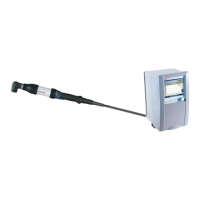3 608 878 300 Tightening Technology | Bosch Rexroth AG 497/641
System 350 | 3 608 878 300/2019-03
is set. Also an error code may be set in the ErrorCode output byte (valid in case of rising edge of
ReportNOK). Acceptance of the result is acknowledged by the PLC by disabling StartReport. In this
case, the tightening controller reacts by removal AckReportStart and clearing of the signals
ReportOK, ReportNOK and ErrorCode.
• ID code (ID-Number and ASCII-String): Here, the ID codes for the component to be processed are
set by the PLC. The ID codes are applied with rising edge of InPos and saved internally. Additionally,
the ID codes are transferred to the involved applications (or the tightening channels).
• FOx_PosNo: The position number is internally used for generation of the application and channel IDs.
The position number must be applied 200ms before the actual start of the application (via FO_CW/
FO_CCW).
• Type_No: The type number is used internally to establish the list of assignment between tightening
channels, programs and PLUS-QIs in the tightening system configuration. In case of rising edge of
InPos, the Type_No has to be applied and is then internally checked and generated after checking
of signals AckInPos or AckTypOk.
• ChnErrAck: A new channel system error was applied by the PLC (see below, signals Ch_ErrCode/
Ch_ChnNum/Ch_ErrClass). This is the acknowledgement for the ChnErr signal. With rising edge of
ChnErr, the tightening controller indicates that a new channel system error is available for
acceptance by the PLC. The error is read and ChnErrAck is set by the PLC. Afterwards, acceptance
is recognized and marked internally by the tightening controller and the signal ChnErr is reset. This
must also be acknowledged by the PLC by disabling of ChnErrAck. Both participants are now ready
for new transmission of system errors.
Additional general instructions:
• If data is not to be transmitted to PLUS for specific tightening processes, internal data processing
can be prevented by setting the FOx_DisRp signal
• The position information is always evaluated. For applications without positioning, a fixed position
number must be transmitted and also configured in BS350 (typically 0).
Table 6–180: Outputs
Signal Data type Address Signal name/description Validity/notes
ReportOK Bool %0.5 Report OK One of the two signals is set to
indicate to the PLC the end of
the PLUS transmission started
by StartReport.
ReportNOK Bool %0.6 Report NOK
AckReportStart Bool %0.7 Acknowledge start report The signal is set as
acknowledgement of
StartReport (and reset after
reset of StartReport).
AckInPos Bool %1.0 Acknowledge in position Acknowledgement for InPos of
the PLC (see above)
AckTypOk Bool %1.1 Acknowledge for TypeNo OK Acknowledgement that
Type_No of the PLC was
correctly applied (see above).
ChnErr Bool %1.2 New channel error active Rising edge indicates validity of
channel system errors (see
above)
ErrorCode Byte %56 Error code for AckReportStart Error code if ReportNOK was
set.
KE_ErrCode Word %57 Error code of KE system error Set as long as a system error is
active. If no KE system error,
KE_ErrCode = 0.
KE_ErrClass Byte %59 Error class of KE system error
Ch_ChnNum Byte %60 Applicable channel number for
the following two fields
Valid with rising edge of ChnErr
Ch_ErrCode Word %61 Channel system error code
Ch_ErrClass Byte %63 Channel system error class
KE_ErrCode Word %57 Error code of KE system error

